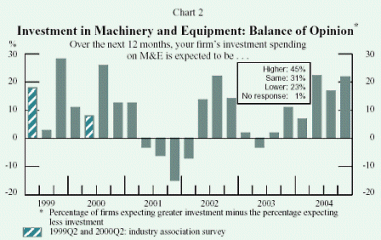Winter 2004-05
About the Survey
The Business Outlook Survey and the document Adjusting to the Appreciation of the Canadian Dollar summarize interviews conducted by the Bank's regional offices with the senior management of about 100 firms, selected in accordance with the composition of Canada's gross domestic product. The survey's purpose is to gather the perspectives of these businesses on topics of interest to the Bank of Canada (such as demand and capacity pressures) and their forward-looking views on economic activity. Details of the survey and its content are discussed in the article, "The Bank of Canada's Business Outlook Survey," published in the spring 2004 issue of the Bank of Canada Review. The winter 2004-2005 survey was conducted from 16 November to 15 December.
The opinions expressed are those of the respondents and do not necessarily reflect the views or policies of the Bank of Canada. The method of sample selection ensures a good cross-section of opinion. Nevertheless, the statistical reliability of the survey is limited, given the small sample size.
Bank of Canada regional offices: Atlantic Provinces (Halifax), Quebec (Montréal), Ontario (Toronto), Prairie Provinces, Nunavut, and Northwest Territories (Calgary), British Columbia and Yukon (Vancouver)
Overview
- Businesses remain positive about the economic outlook but less so than in the autumn survey. The appreciation of the Canadian dollar between the survey periods has heightened uncertainty among businesses and dampened the expectations of those adversely affected by the rising dollar.
- As in the previous survey, indicators are stronger for firms based in Western Canada than for those in Central and Eastern Canada.
Business activity
- Firms continue to report strong sales over the past year. They expect sales to improve in the next 12 months, but the balance of opinion is less positive than in the autumn survey.
- Pressure on production capacity remains as high as in the autumn survey.
- In this environment, intentions regarding investment spending and hiring continue to be strong.
Prices and inflation
- Companies expect the prices of their inputs to rise less rapidly over the next 12 months than was the case over the past 12 months. This largely reflects a slowing in the pace of increase in commodity prices.
- Firms also expect output prices to increase more slowly over the next 12 months, mainly because of less upward pressure on input costs.
- Inflation expectations have changed very little from the last survey and continue to be well anchored within the Bank's target range of 1 to 3 per cent.
SELECTED RESULTS FROM THE WINTER 2004-05 BUSINESS OUTLOOK SURVEY
Data for the chartsOutlook for Business Activity

The balance of opinion among firms regarding future sales growth remains positive but has been dampened by the appreciation of the Canadian dollar between the two surveys. The shift in outlook was most pronounced in the primary sector and in manufacturing. In the primary sector, the decline in the balance of opinion was also partly the result of a slowing in sales growth from the very strong pace observed earlier in the year. Companies in Western Canada continue to have a more positive outlook than those in Central and Eastern Canada.

Investment intentions for expenditures on machinery and equipment continue to be strong. The investment outlook remains solid for businesses in the services sector and has improved for those in the goods-producing sector. Some manufacturers indicated a desire to improve productivity by boosting their investment in technology.

Employment intentions have strengthened. The outlook for hiring continues to be the most positive in the services sector.
Pressures on Production Capacity

The number of firms reporting that they would have difficulty meeting an unexpected increase in demand was essentially unchanged, suggesting continued pressure on production capacity. These constraints were most pronounced in the resource sector.

Labour shortages were most commonly reported in the resource sector, but were also mentioned by many service firms, particularly those in retail and wholesale trade, transportation, and engineering. Labour shortages remain more prevalent among firms in Western Canada.
Outlook for Prices and Inflation

Firms expect the prices of inputs to rise at a slower pace over the next 12 months. Many firms are, in fact, expecting input prices to decline over the next 12 months. At the time of the survey, the decrease in the prices of oil and many other commodities from their previous peaks led to expectations of lower price increases going forward. Moreover, businesses are still expecting the higher Canadian dollar to put downward pressure on input prices.

Businesses also expect output prices to increase more slowly than they did over the past 12 months. Many expect to pass a slowing in the cost of their inputs on to their customers.

Inflation expectations are largely unchanged. The majority of firms are expecting consumer price inflation over the next two years to be within the Bank's target range of 1 to 3 per cent.




